| Hôtel de Beauvais | |
|---|---|
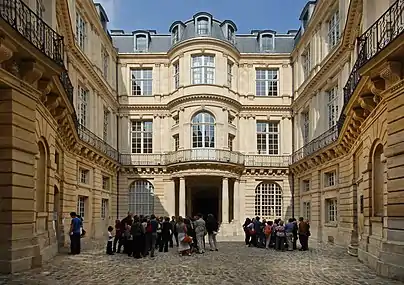 | |
| General information | |
| Type | Hôtel particulier |
| Address | 68, rue François Miron |
| Town or city | Paris |
| Country | France |
| Completed | 1660 |
| Design and construction | |
| Architect(s) | Antoine Le Pautre |
The Hôtel de Beauvais is a hôtel particulier, a kind of large townhouse of France, at 68 rue Francois-Miron, 4th arrondissement, Paris. Until 1865 rue Francois-Miron formed part of the historic rue Saint Antoine and as such was part of the ceremonial route into Paris from the east. The hotel was built by the royal architect Antoine Le Pautre for Catherine Beauvais in 1657. It is an example of eclectic French baroque architecture.
History

Catherine Beauvais was the first lady to Anne of Austria, and was rumored to have provided Louis XIV with his first heterosexual experience.[1] Favoured by the Queen regent, Catherine Beauvais was given gifts of money and later expensive building materials that had been destined to be used in the extension of the Cour Carrée of the Louvre Palace. The Hôtel Beauvais was built partly over land that had belonged to Cistercian monks during the 13th century. All that is left of their town house is the vaulted cellar that has been preserved in the basement of the 17th century building.
_BnF_RES-V-371_045r-f97_H%C3%B4tel_de_Beauvais%252C_Principale_entr%C3%A9e_(adjusted).jpg.webp)
On August 26, 1660, King Louis the XIV and his new wife Maria-Theresa made a triumphal entry into Paris, stopping at the Hotel de Beauvais to salute Beauvais, who stood on the protruding balcony that overlooked the street. In 1763 the hotel came into possession of the Bavarian ambassador, who received a visit that year from Mr. Leopold Mozart, his wife, and children, including Wolfgang, age seven. During the French Revolution the building was requisitioned by the state and sold to a private individual. In 1800 the building was divided up into 40 apartments. The building was significantly changed and some parts became damaged or demolished. An extra floor is also added between the first and second floors in order to create extra rental space. In 1918, the building was damaged during shelling. Until 1987 the Hôtel was home to a variety of tenants including a school and, between 1941 and 1972, a private maternity clinic. During the Nazi occupation Jewish residents were moved out.
In 1926 the Hôtel de Beauvais was partly listed as a historical monument because of its main entrance, the grand staircase and the façade overlooking the central courtyard. The entirety of the building wasn't listed until 1966. In the early 20th century, the building was in danger of demolition as part of an effort to redevelop poor and insalubrious areas of the city. The Marais and the areas around what is now the Pompidou Centre are particularly targeted. However, due to the efforts of the Minister of Culture André Malraux and heritage activists, much of the Marais was slowly restored during the late 20th century rather than demolished. Between 1967 and 1970 the medieval cellar was cleared and restored by the association Paris Historique.[2] The restoration of the building was completed in 2003, and today contains the administrative court of appeal of Paris and is mostly inaccessible to the public except for the court public audiences. However, the historic parts of the building can be visited during European Heritage Days. The building can also be visited once a month under the auspices of Paris Historique. The courtyard has been used as a theatre, notably during the Festival du Marais.[3]
Architecture
Hôtel de Beauvais’ façade is in the French Baroque style, common to hôtels particuliers. Strict symmetry is created using false walls and windows.[4] The façade uses vertical bands of rusticated stone and horizontal moldings instead of orders to define major lines.[5]
Novel Elements & Precedents
The building contains several unexpected elements for an hôtel particulier. Public shops are located along the ground level, which may be a continuation of an ancient Roman tradition. The mezzanine windows, which were uncommon in Paris, may have been a throwback to High Renaissance in Rome.[6] In the plan, there are different paths for circulation for servants and noblemen. Many unusual details of the plan: the corps de logis placed along the street with the cour d’honneur behind, the circular vestibule, the angled passage from the court to the rue de Jouy, the semicircular ending of the court, and the stair at the left rear of the court, were the result of Le Pautre's use of the foundations of the three medieval houses that originally occupied the lot.[7]
Critical reception
Le Pautre's major triumph was in his treatment of the irregular site and the creation of a symmetrical façade.[8] Architectural historians also laud the building for its influence on the free plan; seen in the central cour d’honneur, created by the articulation of pochè and an ambivalence towards solid space.[9]
- Plans
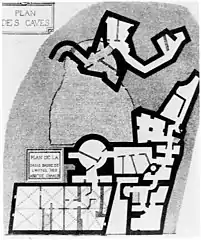 Foundations of the original medieval building with the outline of the completed cour d’honneur.
Foundations of the original medieval building with the outline of the completed cour d’honneur.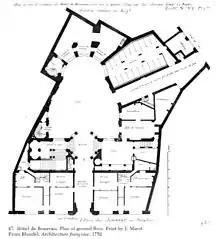 Ground Floor
Ground Floor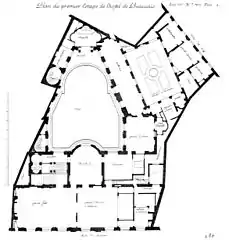 First Floor
First Floor
 The street facade on the rue Saint-Antoine
The street facade on the rue Saint-Antoine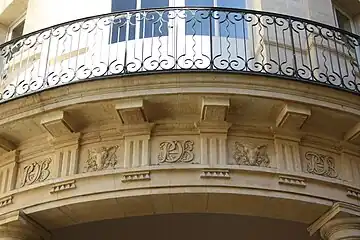 The courtyard balcony with the monogram PCHB, standing for Pierre, Catherine-Henriette, Beauvais
The courtyard balcony with the monogram PCHB, standing for Pierre, Catherine-Henriette, Beauvais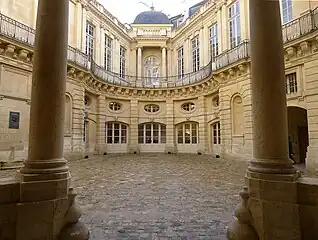 The oval courtyard
The oval courtyard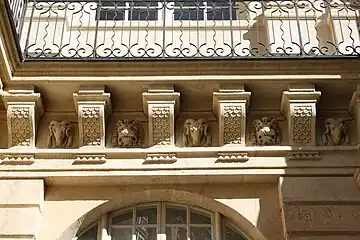 Mascarons on the courtyard balcony frise
Mascarons on the courtyard balcony frise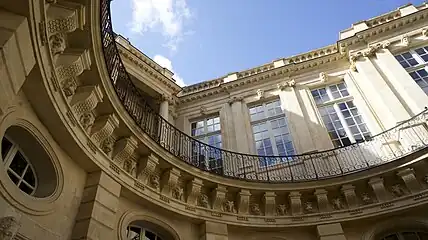 Detail of the courtyard
Detail of the courtyard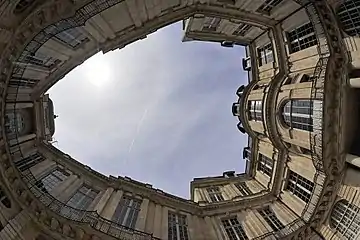 General view of the courtyard, showing its unusual oval shape
General view of the courtyard, showing its unusual oval shape
Notes
- ↑ Robert W. Berger, Antoine Le Pautre: A French Architect of the Era of Louis XIV (New York: New York University Press, 1969), 37
- ↑ Paris Historique website
- ↑ Leonard Pitt, Walks Through Lost Paris (Berkeley: Counterpoint LLC, 2006), 186
- ↑ Berger, Antoine Le Pautre, 40
- ↑ Berger, Antoine Le Pautre, 39
- ↑ Howard Hibbard, The Architecture of the Palazzo Borghese: Memoirs of the American Academy in Rome, XXVII (Rome: American Academy in Rome, 1962), 17
- ↑ M. Du Seigneur, “L’hotel de Beauvais,” La construction moderne (1886), 378-379
- ↑ Kevin Matthews, "Hotel de Beauvais," http://www.GreatBuildings.com/buildings/Hotel_de_Beauvais.html
- ↑ Colin Rowe & Fred Koetter, Collage City (Cambridge, Massachusetts: The MIT Press, 1978), 78]
References
- Berger, Robert W. Antoine Le Pautre: A French Architect of the Era of Louis XIV. New York: New York University Press, 1969.
- Hibbard, Howard. The Architecture of the Palazzo Borghese: Memoirs of the American Academy of Rome, XXVII. Rome: American Academy in Rome, 1962.
- Matthews, Kevin, Hotel de Beauvais, Artifice, Inc., 2008.
- Pitt, Leonard. Walks Through Lost Paris. Berkeley: Counterpoint LLC, 2006.
- Rowe, Colin and Koetter, Fred. Collage City. Cambridge, Massachusetts: The MIT Press, 1978
- Seigneur, M. Du. La Construction Moderne. 1886.